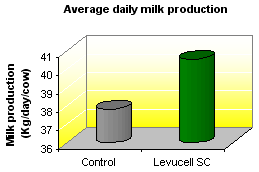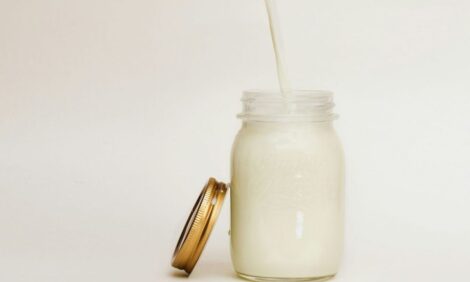



Heat Stress In Dairy Cows: Implications And Nutritional Management
By Lallemand Animal Nutrition. Dairy cows are very sensitive to heat stress, which has a significant economic impact for the farmer: not only loss of productivity and milk quality (increased somatic cells count), but also health related problems.
The farmer is usually aware of some of the essential herd management practices necessary in this critical period, however some nutritional solutions may not be as known. In particular, probiotics, which, by improving rumen conditions and functions affected by the stress factors, can help preserving cows digestive health, milk productivity and animals overall health status. During heat stress periods, the oxidative balance is also affected and it is very important to increase the anti-oxidant intake in order to preserve the cows reproductive health and immunity, preventing mastitis.
1- Defining Heat stress and its implications
The Temperature-Humidity IndexThe severity of heat stress is correlated to both ambient temperature and humidity level (Figure 1). The bovine thermal comfort zone is -13ºC - +25ºC. Within this temperature range, the animal comfort is optimal, with a body temperature between 38.4ºC and 39.1ºC (Lefebvre and Plamondon, 2003). Above 25ºC, and even 20ºC for some authors, the cow suffers from heat stress: its health status and zootechnical performance are affected.
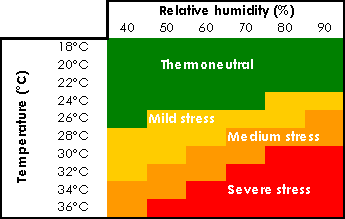
Figure 1. To each temperature/humidity index corresponds a level of thermal stress (Modified from F. Wierama. University of Arizona. 1990).
Severe heat stress can induce financial losses of up to 422 €/cow (St-Pierre et al. 2003). An estimated 80% of these losses are associated with loss of productivity, and 20% with health issues: reproduction and immunity problems, which translate into increased mortality and mastitis frequency in particular (Table 1).
| Table 1: The economic impact of heat stress: estimates from a study conducted under severe heat stress conditions in Florida (USA) (St Pierre et al., 2003). | ||
| Heat stress consequence | Physiological impact (average) | Financial impact (average /cow/year) |
|---|---|---|
| DMI decrease: 6 to 30 % | - 894 kg/cow/year | + 90.5 € |
| Milk production decrease: 15 to 20% | - 1 803 kg/cow/year | - 403.0 € |
| Reproduction efficacy decrease: 40 to 50% | + 59.2 days from calving to conception + 7.99 % culling due to reproductive problems |
- 12.0 € |
| Mortality increase Increased mastitis incidence and severity | + 1.72 % mortality | - 2.3 € |
A disrupted energy balance
Bovines have two main ways of maintaining their thermal balance and regulate their body temperature under high heat conditions. They rely essentially on both:
- Favoring heat dispersion, in particular through evaporation, by increasing subcutaneous blood flow, panting, drooling etc. These activities increase the maintenance energy needs of the animal by an estimated 20% at 35°C. In the case of dairy cow, this means that part of its production energy will be redirected to thermal regulation.
- Limiting heat production, by reducing all activity and changing its feeding pattern. Indeed, heat production in dairy cows is essentially due to rumen fermentations. The cow's DM intake can be reduced by 10-30%. Also, rumination, which produces heat, decreases dramatically. Cows will tend to eat less during the day, but more often and in small quantities. They will tend to consume more feed at night when it is cooler, slug feed, sort feed and tend to choose feeds that produce less heat during digestion, choosing grains and proteins over forages.
In periods of heat stress, the risks of acidosis are increased. Factors that can contribute to rumen acidosis problems are: decreased DM intake with lower proportion of forage and higher levels of fermentable carbohydrates, decreased rumination, decreased saliva to the gut -a source of bicarbonate -, with a reduction of its buffering power due to increased CO2 expelled (panting) (Figure 2). Additionally, the decreased rumen pH impairs fibers digestion efficiency: rumen fibrolytic bacteria are the most affected when rumen pH drops (below 6.0).
All of these factors contribute to decreasing feed efficacy, and, consequently, milk yield, and often milk fat. Moreover, acidosis is proven to affect the animals overall health status, fertility, and bovines longevity.
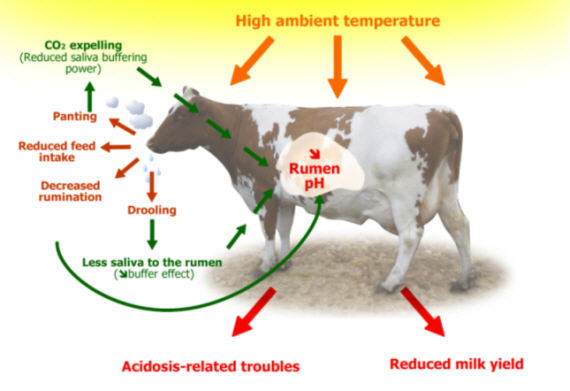
Figure 2: Heat stress, with its physiological and behavioral consequences, increases the risks of rumen acidosis.
2- Heat stress Management
Herd managementIn order to prevent the effects of heat stress, keeping cows comfortable and as cool as possible are key. Adequate fresh clean water must be provided at all times. Shade, fans, misters (in lower humidity areas) and coolers are very effective tools to help lower cow body temperatures during heat stress periods. It is also recommended to distribute feed more frequently. Feeding in the cooler times of the day and pushing up feed more often can also encourage more feed intake.
The nutritionist recommendations
In order to limit the physiological risks linked to heat stress, and in particular rumen acidosis, the ration can be adjusted: high energy, more palatable diets, with high quality, highly palatable forages. In order to prevent acidosis, the ration can also be secured with ruminant specific live yeast. Finally, anti-oxidants intake should be increased (see section 3).
Ruminant specific live yeast secure the rumen for optimal performance
Ruminant specific live yeast Saccharomyces cerevisiae CNCM I- 1077 , or Levucell® SC, is a particular yeast strain deposited at Pasteur Institute, that has been selected and its effects in ruminants validated by international renowned research centers. Over 40 scientific papers have been published on the subject. Three main mechanisms have been identified to explain its effects on ruminants performance and health:
- Improved rumen pH: reduced acidosis risk
- Improved fiber digestion and nitrogen utilization: increased feed efficacy
- Rumen microflora stabilization
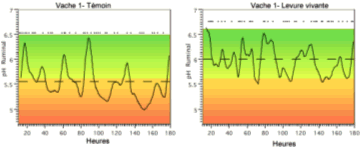
Figure 3: The effects of Levucell® SC on rumen pH variations with a high energy diet (In orange, the acidosis risk zone, where rumen pH< 5.6) ( A. Bach, IRTA, 2007)
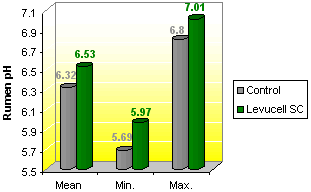
Figure 4: The effects of Levucell® SC on rumen mean, minimum and maximum pH in dairy cows (A. Bach, Minnesota University, 2007).
Field evidences of ruminant specific yeast efficacy
Production trials, conducted in heat stress conditions, illustrate the statistically significant effect of live S. cerevisiae CNCM I- 1077 live yeast on milk yield (see Table 2 and trial details).
| Table 2: The effects of Levucell® SC on dairy cows milk production in summer trials (trials Lallemand, 2003-2004) | |||
| Trial | Period | Duration | Milk production |
|---|---|---|---|
| FARME Institute Inc. NY, USA (2004) | Summer (June- Aug 2004). | 60 days | + 7.2 % + 2.7 kg |
| Shanghai Zhenyuan Dairy Co., China (2003) | Summer, severe stress. | 60 days | + 7.1% + 2 kg |
3- The role of anti-oxidants (selenium)
Heat stress and oxidative stressHeat stress generally increases the production of free radicals, leading to oxidative stress (see boxed text below). In dairy cows, oxidative stress has a negative impact on immune and reproductive functions: increased mastitis frequency and higher somatic cells counts in milk, decreased fertility, increased embryo mortality, post-partum retained placenta, and early calving, with consequences on the calves live weight, mortality and health (Table 3).
| Table 3 : Heat stress impact on heifer fertility (Piton, 2004) | ||
| Parameter | Control | Stressed heifer |
|---|---|---|
| External temp. (°C) | 21.1 | 32.2 |
| Heifer rectal temp. (°C) | 38.5 | 40 |
| Respiratory frequency (mn-1) | 47.3 | 105.3 |
| Conception rate (%) | 48 | 0 |
The role of selenium
In many areas around the world, the soil, and thus the plants and forages are poor in selenium, long recognized for its anti-oxidative properties. In particular, the glutathione peroxydases family of anti-oxidative enzymes, containing selenium incorporated within an amino acid (organic form), plays a major role in maintaining the anti-oxidative balance, protecting the cells from damages (Figure 5-6). It has been shown that the level of anti-oxidative activity of this selenoenzyme is intimately linked to selenium status and dietary intake, hence the necessity of supplementing the ration with selenium. This is even more crucial during heat stress periods, when the oxidative balance is tilted.
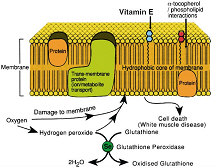 |
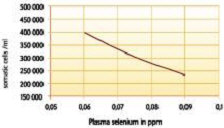 |
|
Fig 5: Vitamin E and Selenium anti-oxydative activity
|
Fig. 6: High level of selenium in the plasma limits the number of somatic cells in milk (Weiss et al. 1990).
|
Choosing the optimal source of bioavailable selenium
Alkosel® R397 is an organic selenium-enriched yeast product (strain Saccharomyces cerevisiae NCYC R397). The specific yeast strain in Alkosel® R397 has been selected for its ability to incorporate high levels of selenium as selenomethionine, a form which is naturally present in plants and animals, and thus far more bioavailable than the mineral form (selenite) .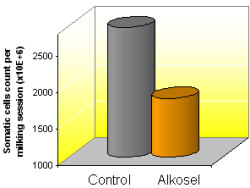
Figure 7: Effect of Alkosel® R397 treatment (in orange: 0.2 ppm organic Selenium vs. 0.2 ppm inorganic selenium ) on somatic cells count in dairy cows. Trial performed in Estonia for a duration of 8 weeks on 100 dairy cows in mid-lactation (Malbe et al. 1995)
Trials have shown that dairy cows supplementation with Alkosel® R397 increased selenium status in the cows blood, milk and colustrum, to higher levels than equivalent doses of mineral selenium. Based on selenium anti-oxidative activity, Alkosel® R397 is able to improve immune and reproductive functions, which are deeply affected by heat stress. For example, it has been shown that organic selenium supplementation played a role in the prevention of retained placenta. Milk quality can also benefit from Alkosel® R397 supplementation: reduced somatic cells (Figure 7), but also higher selenium levels, with obvious added benefits for the calf and the consumer alike, considering the overall low selenium intake in humans in many regions.
Hest stress is a burden for the cows performances and health that costs the diary industry million every year. Implementing adapted herd management techniques as early as possible, before the problems are visible at production level is the key. Nutritional tools, such as ruminant specific live yeast can only help. Field trials show that in stress conditions, it is a good strategy to prevent acidosis risks, optimize feed intake and reduce the negative impact of heat stress on milk production, an effect which is supported by scientific evidence on the live yeast action in the rumen. Moreover, the use of anti-oxidants such as selenium enriched yeast help reducing the impact of heat stress on the oxidative balance, resulting in improved milk quality and cows health.
References
Bach A., Iglesias C. and Devant M., 2007. Animal Feed Science and Technology, Volume 136, Issues 1-2, 15 July 2007, Pages 146-153
Lefebvre D., Plamondon P., 2003 Le Producteur de Lait Québécois, juin 2003
Malbe, M., M. Klaassen, W. Fang, V. Myllys, M. Vikerpuur, K. Nyholm, W. Sankari, K. Suoranta, and M. Sandholm. 1995. J. Vet. Med. (Ser. A) 42:111-121

